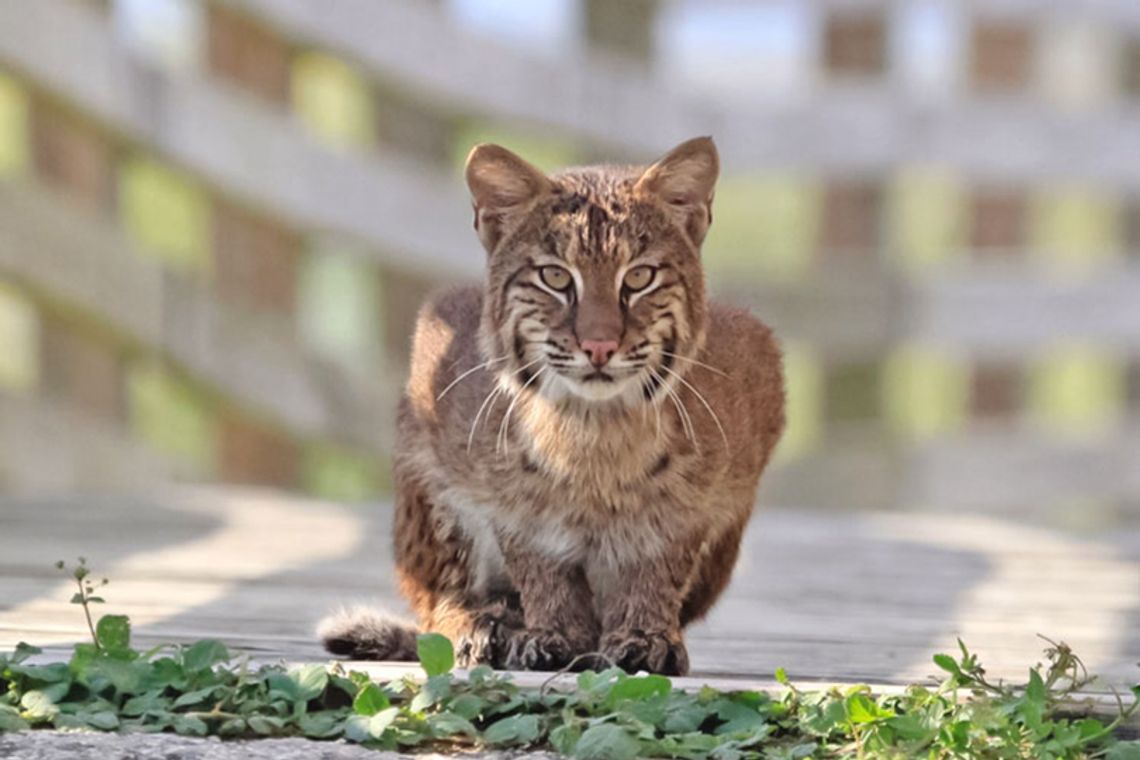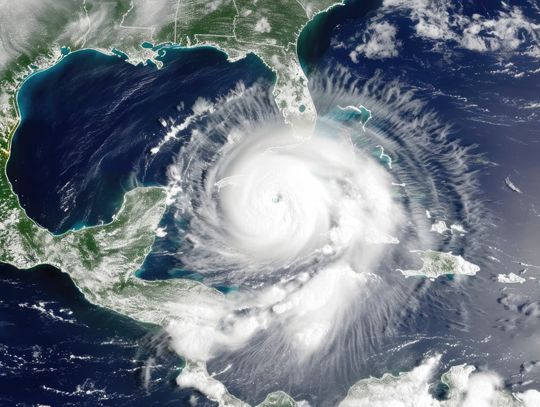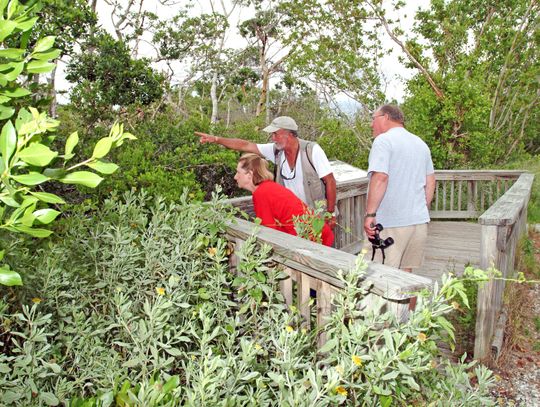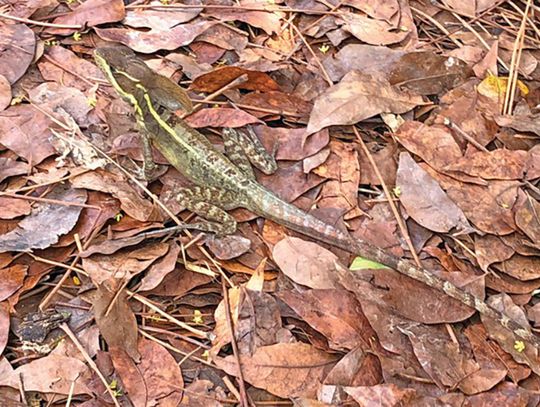A bobcat, like a black bear, is not a “nuisance” animal, although it is a feline.
And felines known as feral cats may be among the most damaging critters in the Florida environment, wildlife ecologists say. Birds, in particular, with a profound effect on the control of insects and the seeding, growth and environments of trees and plants we depend on, are subject to population-depleting predation by feral cats living cheek to jowl with humans, ecologists say.
Like other animals that adapt well to human proximity, whether native or invasive — coyotes, raccoons, opossums, feral hogs, not to mention reptiles and amphibians such as Burmese pythons, cane toads, alligators and iguanas — feral cats can create significant problems, whether or not they make the “nuisance” list. And bobcats don’t make that list.
“The term ‘nuisance’ pertains to the behavior of an individual animal that may be causing conflicts with humans,” explains Ariel Callender, the public information officer for the South Region of the Florida Fish and Wildlife Conservation Commission, or FWC.
Scientists urge Florida residents to report nonnative lizards
“Native Florida wildlife are not considered nuisance species and serve important roles in Florida ecosystems. The FWC provides guidance on ways people can prevent conflicts with native wildlife, which typically will involve the removal and/or securement of any human-provided attractants of food or shelter.”
Yeah. Don’t leave your garbage out and exposed or pile pet food or birdseed outside. And go here, if bears knocked over your garbage cans — or alligators invaded your gated community, coyotes ate your neighbors’ cat, or iguanas are pooping in your pool: myfwc.com/conservation/ you-conserve/wildlife/remove/
There are right ways to deal with nuisance animals (or any others), and wrong ways, the experts say. The wrong way happened last June when Palm Beach County Sheriff ’s deputies were called into a Royal Palm Beach neighborhood where a black bear was hanging around, refusing to leave. Residents stayed inside, worried.
“Of all the non-natives I’ve come across — feral hogs, iguanas, cane toads, feral cats and dogs — feral cats are the worst animal out there, worldwide, hands down.” — Donna Kalil, founder and head of Everglades Avengers
Florida black bears are not only smaller than others in North America, they are rarely or never dangerous to humans, unlike black bears can be in the west.
A few hours later and against the direction of FWC officials, when the bear came down a tree and began to leave, deputies shot it, citing a public threat.
Since then, says Ms. Callender, they’ve likely gotten some training in how to deal with such animals, although the Palm Beach County Sheriff ’s Office didn’t return a phone call and email to confirm that training. But it did provide information on how the PBSO handles escaped livestock and other animal problems.
The FWC response to the incident is included with this story. Which doesn’t solve the cat problem — either bobcat or feral.
That dang bobcat
“Of all the non-natives I’ve come across — feral hogs, iguanas, cane toads, feral cats and dogs — feral cats are the worst animal out there, worldwide, hands down,” says Donna Kalil, founder and head of Everglades Avengers. She doesn’t even mention pythons. Her team of celebrated python hunters enters the Everglades from the east coast by night, and captures then euthanizes the big invasive snakes, selling them when possible, to purse and boot makers, and taking the fee the state now offers for their removal.

She isn’t usually called to the ‘burbs to solve python problems, however, the way sheriffs’ departments, animal control agencies, and the state’s FWC, are called to solve every other kind of animal problem people have.
But when a single bobcat decides to create a big nuisance whether it’s on the nuisance list or not, apparently it can.
“Bobcats are a little special. They aren’t plentiful but they are territorial,” explains Amy Kight, executive director of the nonprofit Busch Wildlife Sanctuary in Jupiter, where a lot of calls asking for help with nuisance animals usually aren’t as dramatic as a particular one, she recalls.

“A woman called and said there was a bobcat that wouldn’t let her out of her house. It didn’t sound rabid to us, because it would come and go.”
That’s not behavior typical of rabid animals. But it didn’t go away, either.
“She kept calling, and curiosity got the best of us, so we went to check it out,” Ms. Kight says. “When we got to her home, she had recently purchased a leopard print couch, and it extended three or four inches past her glass doors.”
It was distinctly visible to anyone outside, looking in.
The problem immediately became clear, Ms. Kight recalls: the bobcat thought a creature behind the glass was trespassing on its territory.
“The bobcat kept seeing this leopard print on the other side of the glass. So we helped her push over her couch just a few inches.”
Suddenly, the couch disappeared to outside viewers.

“It was a wonderful, easy fix,” she says.
The bobcat went away and the woman never saw it again, most likely. Best of all, nobody got shot.
But in a state with more than 500 nonnative fish, animal and plants, goodwill and patient curiosity are not always the response of humans, either to natives or nonnatives.
“Raccoons getting into garbage cans, or pooping in pools, like iguanas — it annoys some people,” Ms. Kight says. “And this time of year is baby season for all kinds of animals, so we have calls about birds, too, swooping at people. Mockingbirds, blue jays, even some birds of prey.”
Her organization, like others, leaves the birds alone, along with raccoons. The law prohibits property owners from trapping and relocating them. “So most of the time, you recognize they’re doing something that attracts the animals in their yard and you educate them.”
Don’t create attractions
One of the keys in living with these kinds of nuisance animals is simply not creating environments that attract them.

“It might be bird feeders, or outdoor cats people feed, or fruit trees — and most of the animals in Palm Beach County are born and raised in urban areas, so they’ve lost some of their natural fear of humans.”
And then there are alligators, for which Busch only occasionally receives calls. “We talk people through it, and there are nuisance wildlife trappers that handle them. Sometimes people are astounded there would be an alligator in a gated community — that the creatures didn’t know they weren’t allowed in there.”
Non-native nuisances such as green iguanas, capable of growing to 6 feet in length and breeding at prolific rates, or pythons, are not looked on as kindly or with a sense of humor.
“Estimates of their populations can be in the tens of thousands to over a hundred thousand,” Rory Feeney, the land resources bureau chief at the South Florida Water Management District has told Florida Weekly.

“Every snake we remove can make a difference, because in five to seven years it could eat hundreds of native animals,” ranging from rabbits, raccoons and opossums to otters to white-ailed deer.”
The pythons have now depleted populations of mammals in the Everglades by as much as 95%, wildlife biologists estimate.
Eradication of the very invasive species is now likely impossible, just as it is for green iguanas, a much more immediate nuisance to humans on both the southeast and southwest coasts, where weather, food and a lack of natural predators created ideal conditions for them to prosper and multiply.
Iguanas can take over neighborhoods near water, overrunning backyards, swimming pool landscaping or areas along seawalls, and eating both native and popular introduced garden plants, like hibiscus.
Frank Mazzotti, a wildlife ecologist and professor at the University of Florida, compares the invasives simply for problems they cause humans.

“Statewide, feral hogs might be at the top of the list, but they’d be fighting a battle with feral cats.
“Feral hogs cause a lot of damage by rooting and burrowing, disturbing soil and eating everything they encounter; and feral cats are notorious predators of birds, small mammals and lizards.”
But why are green iguanas now seemingly so common?
“A little bit of a different story,” he says. “People were aware of their presence for awhile. Everybody just kept saying they’re just confined to urban areas, just eating hibiscus, they don’t provide a threat — until they looked at water management canals, which are lined with iguanas happily burrowing into banks and causing erosion and collapse. So they’re threatening our ability to mange water.”
Iguana reaper
A growing legion of iguana exterminators armed with air rifles and pole nooses have been enlisted to control populations.

“Each mature female can lay up to 80 eggs. So if you guestimate a female every mile, and probably 50% of those eggs will hatch and you have four hatches (in less than a year), you’re going to have a lot of iguanas,” says Chris Harlow, who’s been in the iguana removal business for several years.
He doesn’t use traps, he says, because they don’t produce effective numbers.
His tools are snare poles and air guns.
“You can get more numbers versus a set trap,” he explains. “You can get 20 iguanas in a half-hour sometimes” — in places like Sanibel and Captiva, or along Cape Coral canals.
“Anywhere there’s a body of water. They’re very good swimmers, they can hold their breath for a long time.
“I average about 1,500 to 2,000 a year … that’s 200 a month, something like that. In the summer months you get a lot more, over 100 a day. They’re on the ground feeding, exposed.
“But this time of year they’re up in the trees. It’s breeding season. So there are a lot of variables.”

The prices he charges may not seem like a nuisance to those under invasion from iguanas.
“An individual home is $135 to $155 to come out, and $35 per iguana after the first one.”
And he can solve more than iguana problems, he says. “I remove anything that moves, like armadillos, raccoons, ‘possums, bats, rats, rabbits, even birds, owls, and snakes.”
He’s not euthanizing them, he’s moving them, he notes, and glad to do it. “A lot of times if I don’t get there first a homeowner will kill something that doesn’t need to be killed,” he says.
“But iguanas have to be euthanized on the spot.
Anything invasive, you have to euthanize them. And it’s better just to shoot them.”
Florida’s FWC, an organization far from trigger happy judging by its effort to accommodate wildlife under siege from massively growing human populations, tracks many of the nonnatives now inhabiting the Sunshine State, offering both information and direction about the most common.

But the FWC also offers this general rule of thumb, says Ms. Callender: “Non-native wildlife species in Florida are not protected except by anti-cruelty law (Florida Statutes 828.12). The FWC encourages removal of invasive species to help prevent negative impacts to native wildlife, habitats, and people.”
As for nuisance animals, whether native or not? Best tread lightly. ¦
In the KNOW
Critter 411: Helpful links
Bears: To learn more about bears and how to avoid conflicts with them: MyFWC. com/Bear or BearWise.org. Threats, or bears injured or dead: Call the FWC’s Wildlife Alert Hotline at 888-404- FWCC (3922).
Coyotes: Tips and information about coyotes can be found here: MyFWC.com/ Coyote

Key information about animals you may see
RACCOONS:
Raccoons and other wildlife that have been fed and habituated by humans may display aggressive behavior toward people or pets. To avoid habituating raccoons, do not feed them, and secure any food attractants around your residence, such as trash, grills, bird feeders and fruit or vegetables. It is illegal to feed raccoons in Florida. Hazing unwanted wildlife from around your property can encourage them to move along and help retain their natural fear of humans.
IGUANAS:
Green iguanas are large nonnative, invasive lizards that are established and have reproducing populations in South Florida. Green iguana populations are found in Broward, Martin, Miami-Dade, Monroe, Palm Beach, Collier and Lee counties in Florida. Reports of iguanas in more northern counties are likely escaped or released captive animals. Report sightings of green iguanas at Ivegot1.org, to help biologists track distribution.
Green iguanas negatively impact native plants and wildlife by feeding on a wide variety of vegetation and bird eggs, as well as competing with other native wildlife for the same natural resources.
Individual green iguanas may dig burrows that erode and collapse sidewalks, foundations, seawalls, roadways, berms and canal banks. They can be removed and humanely killed on private property year-round with landowner permission. Landowners can also seek assistance from a professional nuisance wildlife trapper: public.myfwc.com/HGM/NWT/NWTSearch.aspx.
To deter iguanas: Remove plants that could attract them. Fill in holes and gaps under structures to discourage iguanas from burrowing or seeking refuge on your property. Hang wind chimes that make intermittent noises. Hang CDs that have reflective surfaces.
BEARS:
If you see a bear, give it space, do not approach it, and never feed it. To reduce human bear conflicts, remove or secure all food attractants from around your house and yard, including garbage, pet food and bird seed. Store garbage in a sturdy shed or garage and then put it out on the morning of pickup rather than the night before. If not stored in a secured building, modify your existing garbage can to make it more bear-resistant or use a bear-resistant container.
Secure commercial garbage in bear-resistant dumpsters. To avoid encounters between a bear and pets, bang on your door and flip your house lights on and off before letting your pets outside. This will give the bear (and any other wildlife) time to leave the area before your pets come outside. If you do not have a fenced yard, keep your dog on a leash when taking it outside.
COYOTES:
Coyotes are in Florida due to natural range expansion and can be found throughout the state; they have been documented in all 67 Florida counties. Coyotes began expanding their range into northwestern Florida in the 1960s and are now considered to be a naturalized species in all 67 Florida counties. They can be found in several habitat types and are common in rural, suburban and even urban landscapes. They are not considered to be invasive, as they were not introduced to the state by human means.
Coyote observations are often reported more frequently this time of year.
Coyotes in Florida breed in late winter, with a litter of 4-6 pups born after a 63-day gestation. Pups will not emerge from dens until 3-4 weeks of age and will remain with parents until approximately 9 months of age. Coyotes denning with pups may be more protective and defensive, as many species are when raising offspring.
Coyotes raising pups do have increased needs for food sources, so it is always a good idea to remove any attractants from around your home and to take steps to prevent interactions between coyotes and pets.

























Comment
Comments